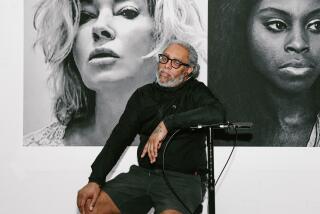Review: ‘Boom for Real’ dives into a teenage Basquiat’s energetic, emergent brilliance
Great artists who die young still have long lives, as evidenced by not just their work but the mythologizing that swirls around their legacy. But what’s refreshing about Sara Driver’s look-back documentary on one such towering figure, “Boom For Real: The Late Teenage Years of Jean-Michel Basquiat,” is the frisky, contemplative, ground-level angle it takes on its hype-magnet of a subject.
Just last year, a colorfully raw 1982 “Untitled” work of Basquiat’s shattered art sales records with a $110 million purchase price at Sotheby’s, the largest amount ever paid for an American artist. Basquiat, a believer in his eventual prominence who died from a drug overdose in 1988 at age 27, surely wouldn’t have been surprised. And yet Driver, a filmmaker with deep roots in the underground New York art scene from which Basquiat emerged, isn’t interested in the ’80s version of the Brooklyn-born phenomenon — living the anointed genius’ spotlit existence — but rather the wily, charismatic street kid whose percolating talent clearly foreshadowed greatness.
Early on, in its archival photographs and film clips, it’s more explicitly a story of a decaying New York in the 1970s, when the Lower East Side was a forgotten zone of crime, poverty and existential risk. But out of it grew an urgent art built from graffiti, and one of its more exciting practitioners was the 17-year-old Basquiat, whose “SAMO” tag — starting around 1977 — and briskly funny, evocative, spray-painted verse touching on race, power and culture in America seemed to underline a new mood among downtown artists: molds were ready to be broken, and creativity wouldn’t be confined.
What emerges from interviews with figures of the time — including artists Al Diaz (who developed “SAMO” with Basquiat), Fred Brathwaite (a.k.a. Fab 5 Freddy), Kenny Scharf and Lee Quinones, plus writer Luc Sante, filmmaker Jim Jarmusch (Driver’s longtime partner) and ex-girlfriend Alexis Adler — in conjunction with Driver’s effortless mix of the era’s edgy images and music, is a picture of a cheap but fertile urban playground. From abandoned buildings and subway yards to the anything-goes scenes at Club 57 and Mudd Club, we sense an unending font of invention, friendship and influence for a homeless teenager with an innate sense of what could command attention and further his ambition.
Dependent on crash pads, and seemingly able to be wherever something was happening and enrich it, Basquiat exhibited a thrilling knack for absorption and reconstitution. It enlivened everything he turned out, whether graffiti scrawls and sculpture or industrial noise music and color-copied collage. To colleagues and companions, his in-the-moment sensitivity to making art — transforming walls, objects, clothes, canvases and, with his piercing eyes and sly smile, even the spaces he inhabited — seemed to embody the medium-hopping spirit of the time, inspiring wonder, jealousy and a certainty that big things were destined for him.
Driver avoids juicing Basquiat’s story in terms of a legend’s hallowed origins, however. If anything, the juxtaposition of anecdotes and remembrances with footage and photographs in which Basquiat doesn’t speak — many of the clips coming from private collections and Glenn O’Brien’s time capsule indie “Downtown 81,” which starred the artist as a version of his then-struggling self — leave him seeming like an elusive ghost. It’s a curious, voice-eliding choice that might not have worked if the testimony-driven depiction of his adolescent, ascendant talent wasn’t ultimately so respectfully human and honest, and as much about the atmosphere as the young man who glided through it.
Basquiat’s energetic brilliance is mourned as much as revered in “Boom for Real,” which ends with his cannon shot into the money-mad, drug-fueled ’80s. What lingers, though, is a heartfelt reminiscence for what’s memorable about emergent talent, the spark that precipitates the well-fanned blaze.
-------------
‘Boom for Real: The Late Teenage Years of Jean-Michel Basquiat’
Not rated
Running time: 1 hour, 18 minutes
Playing: Landmark NuArt, West L.A.
See the most-read stories in Entertainment this hour »
Movie Trailers
More to Read
Only good movies
Get the Indie Focus newsletter, Mark Olsen's weekly guide to the world of cinema.
You may occasionally receive promotional content from the Los Angeles Times.






